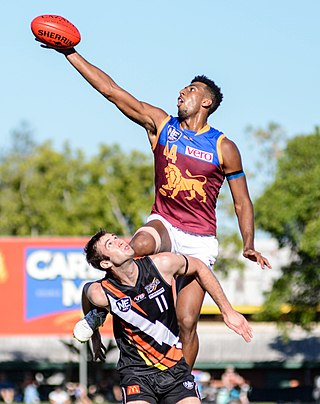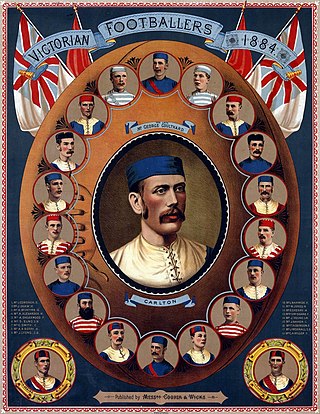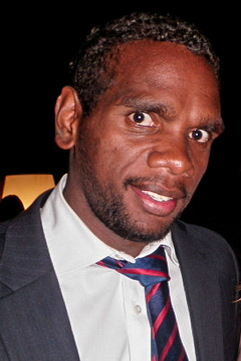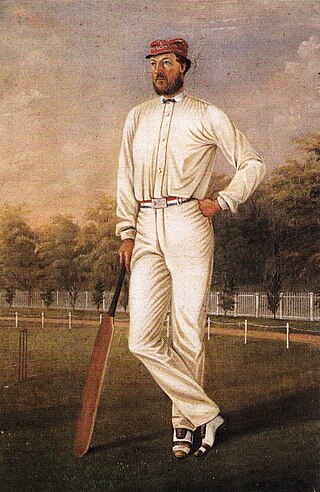Related Research Articles

Australian rules football, also called Australian football or Aussie rules, or more simply football or footy, is a contact sport played between two teams of 18 players on an oval field, often a modified cricket ground. Points are scored by kicking the oval ball between the central goal posts, or between a central and outer post.

The culture of Australia is primarily a Western culture, originally derived from the United Kingdom but also influenced by the unique geography of Australia and the cultural input of Aboriginal, Torres Strait Islander and other Australian people. The British colonisation of Australia began in 1788, and waves of multi-ethnic migration followed. Evidence of a significant Anglo-Celtic heritage includes the predominance of the English language, the existence of a democratic system of government drawing upon the British traditions of Westminster government, parliamentarianism and constitutional monarchy, American constitutionalist and federalist traditions, and Christianity as the dominant religion.

Thomas Wentworth Wills was an Australian sportsman who is credited with being Australia's first cricketer of significance and a founder of Australian rules football. Born in the British penal colony of New South Wales to a wealthy family descended from convicts, Wills grew up in the bush on stations owned by his father, the squatter and politician Horatio Wills, in what is now the state of Victoria. As a child, he befriended local Aboriginal people, learning their language and customs. Aged 14, Wills went to England to attend Rugby School, where he became captain of its cricket team and played an early version of rugby football. After Rugby, Wills represented Cambridge University in the annual cricket match against Oxford, and played at first-class level for Kent and the Marylebone Cricket Club. An athletic bowling all-rounder with tactical nous, he was regarded as one of the finest young cricketers in England.

In 1868, a cricket team composed of Aboriginal Australians toured England between May and October of that year, being the first organised group of Australian sportspeople to travel overseas. It would be another ten years before an Australian cricket team classed as representative left the country.

Marn Grook, marn-grook or marngrook is the popular collective name for traditional Indigenous Australian football games played at gatherings and celebrations by sometimes more than 100 players. From the Woiwurung language of the Kulin people, it means "ball" and "game".
Martin Joseph Flanagan is an Australian journalist and author. He writes on sport, particularly Australian rules football. Flanagan also writes opinion pieces, some of which are examinations of Australian culture and the relationship between Indigenous and non-Indigenous Australians.

St Patrick's College, sometimes referred to as St Pat's, Paddy's or SPC, is an independent Catholic secondary day and boarding school for boys, located in central Ballarat, Victoria, Australia. The school was founded by the Congregation of Christian Brothers in 1893, who continue to run the school through Edmund Rice Education Australia. The school provides education for boys from Year 7 to Year 12, with an emphasis on academic and sporting programs.

Henry Colden Antill Harrison was an athlete and Australian rules footballer who played a leading role in pioneering the sport.

Australian rules football is the most watched and second most participated code of football in Victoria. Australian rules football originated in Melbourne in the late 1850s and grew quickly to dominate the sport, which it continues to. Victoria has more than double the number of players of any other state in Australia accounting for approximately 42% of all Australian players in 2023 and continues to grow strongly. Soccer is the only football code that is more popular than Australian rules in Victoria, though it has made up much ground lost to soccer over previous decades. Today, they have a similar number of players. The sport is governed by AFL Victoria based in Melbourne. The national governing body, the AFL Commission is also based in Melbourne.
Australian Aboriginal culture includes a number of practices and ceremonies centered on a belief in the Dreamtime and other mythology. Reverence and respect for the land and oral traditions are emphasised. Over 300 languages and other groupings have developed a wide range of individual cultures. Due the colonization of Australia under terra nullius concept these cultures were treated as one monoculture. Australian Aboriginal art has existed for thousands of years and ranges from ancient rock art to modern watercolour landscapes. Aboriginal music has developed a number of unique instruments. Contemporary Australian Aboriginal music spans many genres. Aboriginal peoples did not develop a system of writing before colonisation, but there was a huge variety of languages, including sign languages.

Australian rules football has had a significant impact on popular culture in its native Australia, capturing the imagination of Australian film, art, music, television and literature.
Brent Tasman Crosswell is a former Australian rules footballer who played for the Carlton Football Club, North Melbourne Football Club and Melbourne Football Club in the Victorian Football League (VFL).

The origins of Australian rules football date back to the late 1850s in Melbourne, the capital city of Victoria.

Liam Jungarrayi Jurrah is a former professional Australian rules footballer who played with the Melbourne Football Club in the Australian Football League (AFL).
James Bogne "J. B." Thompson was one of the creators of the original laws of Australian rules football, one of the founders and the inaugural secretary of the Melbourne Football Club, a cricketer for Victoria and the Melbourne Cricket Club (MCC), and a journalist for Melbourne newspaper, The Argus.
Bruce Myles is an Australian actor and film director. He has appeared in 40 films and television shows since 1963. In 1987, along with Michael Pattinson, he co-directed the film Ground Zero. It was entered into the 38th Berlin International Film Festival.

In 1870, Irish Australian artist William Handcock completed a portrait of Tom Wills, Australia's pre-eminent cricketer of the mid-19th century and one of the key founders of Australian rules football. It is unknown who commissioned the work or where it was kept after completion, but in 1923 it was acquired by the Melbourne Cricket Club through its then-secretary, Test cricket great Hugh Trumble.

George Jeremiah Patrick O'Mullane was an Australian cricketer and Australian rules footballer. Born and raised in Melbourne, Victoria, O'Mullane was a standout cricketer from an early age, and came to be regarded as his colony's premier wicket-keeper. During the winter months, he excelled as a footballer in the nascent Australian game, receiving praise for his courage and strength.

The Call is a historical novel by Australian writer Martin Flanagan. It was first published by Allen & Unwin in 1998.
Cambridge University Australian Rules Football Club, founded in the early 20th century, is the Australian rules football club for Cambridge University. Both men's and women's teams represent the club in the National University League, the Fitzpatrick Cup, and the annual Oxford-Cambridge Varsity match, among other things.
References
- ↑ Flanagan, Martin (6 November 1998). "The Summer Game". The Sports Factor (Interview). Interviewed by Amanda Smith. ABC Radio National. Archived from the original on 22 July 2012. Retrieved 29 August 2013.
- ↑ Judd, Barry (2007). Australian Game, Australian Identity: (Post) Colonial Identity in Football (PhD). Melbourne, Vic.: Monash University. pp. 154–156, 336. Archived from the original on 17 June 2013.
- ↑ Flanagan, Martin (23 May 2003). "Songs of a defiant heart", The Age. Retrieved 18 October 2013.
- ↑ Schaefer, René (5 October 2010)."The Holy Sea – Ghosts of the Horizon", Mess+Noise. Retrieved 4 April 2013.
- ↑ Flanagan, Martin (5 August 2016). "Tom Wills one hell of a story", The Age. Retrieved 5 August 2016.
- ↑ Morreti, Daniel (1 December 2010). "Short Film Big On Action" Archived 2012-03-28 at the Wayback Machine , Film Ink. Retrieved 22 September 2015.